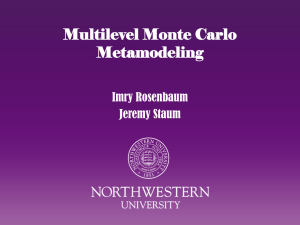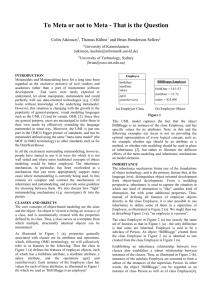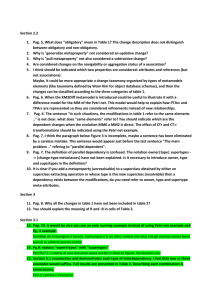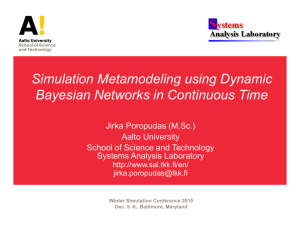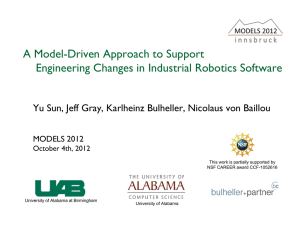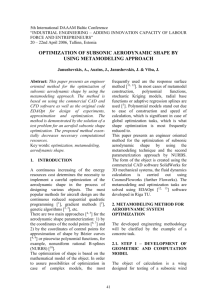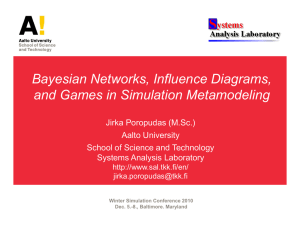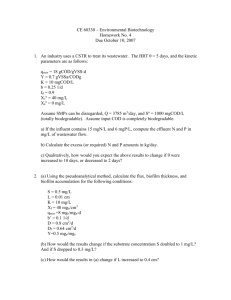Sprinkle_JM_4_0_2001_The_New_Me
advertisement
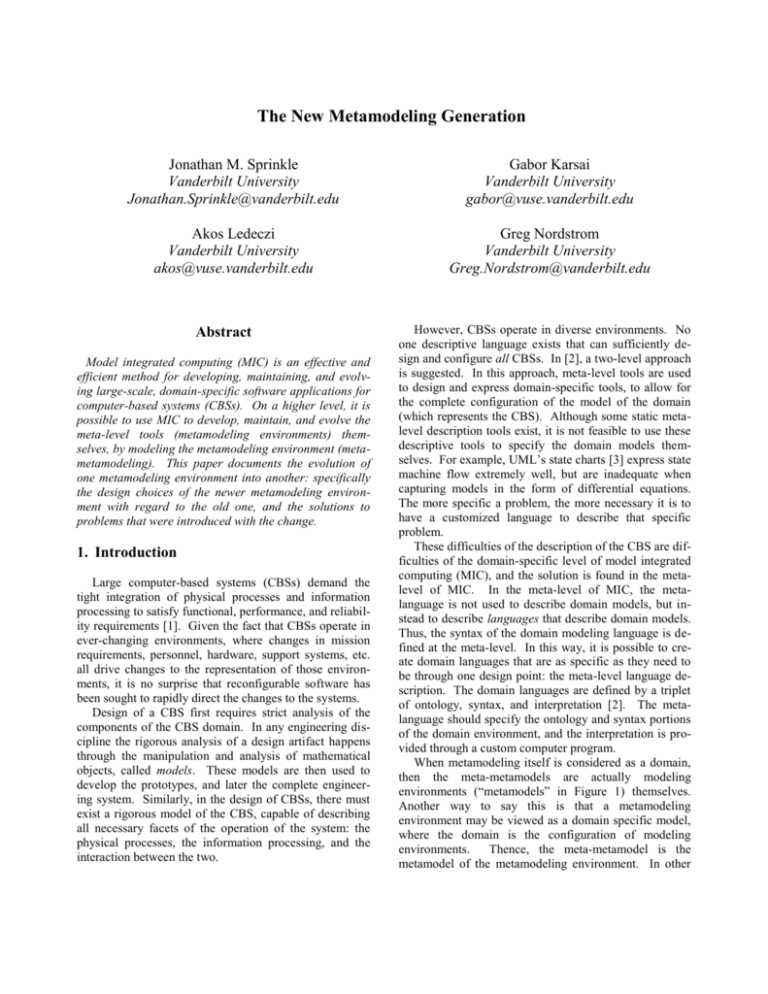
The New Metamodeling Generation Jonathan M. Sprinkle Vanderbilt University Jonathan.Sprinkle@vanderbilt.edu Gabor Karsai Vanderbilt University gabor@vuse.vanderbilt.edu Akos Ledeczi Vanderbilt University akos@vuse.vanderbilt.edu Greg Nordstrom Vanderbilt University Greg.Nordstrom@vanderbilt.edu Abstract Model integrated computing (MIC) is an effective and efficient method for developing, maintaining, and evolving large-scale, domain-specific software applications for computer-based systems (CBSs). On a higher level, it is possible to use MIC to develop, maintain, and evolve the meta-level tools (metamodeling environments) themselves, by modeling the metamodeling environment (metametamodeling). This paper documents the evolution of one metamodeling environment into another: specifically the design choices of the newer metamodeling environment with regard to the old one, and the solutions to problems that were introduced with the change. 1. Introduction Large computer-based systems (CBSs) demand the tight integration of physical processes and information processing to satisfy functional, performance, and reliability requirements [1]. Given the fact that CBSs operate in ever-changing environments, where changes in mission requirements, personnel, hardware, support systems, etc. all drive changes to the representation of those environments, it is no surprise that reconfigurable software has been sought to rapidly direct the changes to the systems. Design of a CBS first requires strict analysis of the components of the CBS domain. In any engineering discipline the rigorous analysis of a design artifact happens through the manipulation and analysis of mathematical objects, called models. These models are then used to develop the prototypes, and later the complete engineering system. Similarly, in the design of CBSs, there must exist a rigorous model of the CBS, capable of describing all necessary facets of the operation of the system: the physical processes, the information processing, and the interaction between the two. However, CBSs operate in diverse environments. No one descriptive language exists that can sufficiently design and configure all CBSs. In [2], a two-level approach is suggested. In this approach, meta-level tools are used to design and express domain-specific tools, to allow for the complete configuration of the model of the domain (which represents the CBS). Although some static metalevel description tools exist, it is not feasible to use these descriptive tools to specify the domain models themselves. For example, UML’s state charts [3] express state machine flow extremely well, but are inadequate when capturing models in the form of differential equations. The more specific a problem, the more necessary it is to have a customized language to describe that specific problem. These difficulties of the description of the CBS are difficulties of the domain-specific level of model integrated computing (MIC), and the solution is found in the metalevel of MIC. In the meta-level of MIC, the metalanguage is not used to describe domain models, but instead to describe languages that describe domain models. Thus, the syntax of the domain modeling language is defined at the meta-level. In this way, it is possible to create domain languages that are as specific as they need to be through one design point: the meta-level language description. The domain languages are defined by a triplet of ontology, syntax, and interpretation [2]. The metalanguage should specify the ontology and syntax portions of the domain environment, and the interpretation is provided through a custom computer program. When metamodeling itself is considered as a domain, then the meta-metamodels are actually modeling environments (“metamodels” in Figure 1) themselves. Another way to say this is that a metamodeling environment may be viewed as a domain specific model, where the domain is the configuration of modeling environments. Thence, the meta-metamodel is the metamodel of the metamodeling environment. In other words, the metamodeling environment is customizeable by its own model (the meta-metamodel). The importance of this view allows for the evolution and rapid configuration of a CBS that is the metamodeling environment. While perhaps at first this may come as a stretch, the consequences of such a view are reasonable. When the metamodeling environment is viewed as a CBS, then it can change to satisfy the function, performance, and reliability requirements of its users (metamodelers). Fortunately, due to the four-layer modeling view, as long as the metamodeling environment can accurately configure domain modeling environments in the same way, then the evolution and reconfiguration of the metamodeling environment is transparent to the domain modeler. Meta-Metamodels describe Metamodels describe Since the metamodeling environment is the configuration point of domain environments that use the MGA tools, it would need to change to allow for the new configuration possibilities. Besides all of the changes to the architecture, a more basic change was requested: to make the metamodeling process more intuitive, easier to use. This alone was enough reason to evolve the metamodeling environment, but the change coincided with the MGA modifications because of the practicality of making one mass change to the metamodeling environment and writing one interpreter, rather than two incremental changes which would have required the development of two interpreters. It is important to note that the changes to the core layer and the changes of the metamodeling environment are two separate types of changes. The metamodeling environment models the core layer of modeling, resulting in an environment to generate domain-specific modeling environments (DSMEs), so changes to the MGA could have just been reflected in the meta-metamodel. Likewise it would have been possible to evolve the metamodeling environment and then express the same MGA in the new metamodeling language, resulting in the exact same output as the previous metamodeling environment. It just happens that both were changed at the same time. Domain Models describe Computer based system Figure 1: The four layers of modeling In fact, as stated in [4], the four-layer modeling architecture was designed to create the infrastructure for future metamodeling language extensions. In other words, changes to the metamodeling environment were anticipated from the beginning of the design, and the fourlayer design emerged as the solution to making these changes as painless as possible for all modeling parties. Therefore, whenever changes to the environment were deemed necessary, changes could occur. Since the MGA, which is the underlying syntax of all models, was changed, it is not entirely true to say that the changes to the metamodeling environment remain totally transparent to the domain modeler (as previously claimed during the discussion of the four-layer modeling architecture). In fact, the domain modeler had to make several transformations to migrate domain models into the modeling environment of the new version of the MGA. Once these transformations were complete, however, the domain modeler dealt no longer with migration problems. As the only necessary transformations were because of the MGA layer, the evolution of the metamodeling environment (from a representation point of view) is indeed transparent to the domain modeler in the normal realm of metamodeling evolution. Note that with the MGA changes, the domain modeler would have been forced to migrate all domain models regardless of a change in the metamodeling environment. 2. Motivation for environment changes The initial prompting for a change in the metamodeling environment was a change in the definition of core modeling concepts. Through user requests and in-house change requests, it was decided to evolve some of the fundamental entities of the Multi-graph Architecture (MGA), developed at Vanderbilt University. These changes resulted in raising the level of involvement of several types of entities. Also, some basic name changes were made (e.g. Categories are now called Folders). 3. Changes in the MGA There were two important types of changes in the MGA tools that required modification in the metamodeling environment. Firstly, several of the objects changed in name. A Conditional Controller in the old environment would now be known as a Set. Since the function of this abstraction has always been to group items together, the name set was more appropriate and descriptive, and adopted for the new MGA revision. Another important change was the changing of the name Category to Folder. Folders, along with the syntax change, changed slightly semantically in that now they behave much more like folders on a disk drive, with the ability to store not only Models, but other Folders as well. Secondly, and more semantically important, several objects which before had a limited ability in the modeling interface (i.e. could not be represented by icons, could not display names) were promoted to the level of a First Class Object (FCO). In the previous versions of the MGA tools, first class objects were Models and Atoms. Connections, References, and Sets as well as Models and Atoms are now FCOs. Along with this increase in ability came the requirement that those objects be configurable in the same way that all other FCOs are. Another change in the core layer of the MGA was the storage medium of the model definition files. The decision was made to move from the editor definition file (edf) format (a proprietary file format) to XML format to increase standardization, and also to take advantage of the built-in scoping, definition, and validation abilities of the XML format. The change from edf to XML is not obviously significant from the modeling perspective. What makes this change significant is the role of scoping and definition. With the XML format, it is possible to give entities such as Constraints a scope, and the metamodeling environment must be able to configure the Constraints appropriately. ronment. The old metamodeling environment could accurately model all of these abstractions. The two most significant differences between the old and new metamodeling environments are the semantics of the class diagram, and the representation of the data. 4.1. Class diagram semantics The most significant request of metamodeling users was to reduce the amount of redundant specification that was necessary. Therefore, the most significant change to the metamodeling environment is the terseness of the semantic representation. In the old metamodeling environment, a class diagram was created, and separate from that class diagram it was necessary to create a separate model to represent each FCO (Model and Atom) and each Attribute. The class diagram that was created did not contribute to the actual definition of much of the modeling environment, and concepts such as inheritance had to be hand enforced in the model creation. This method, while sufficient for describing model paradigms, was cumbersome and error prone in practice. Table 2: Fundamental modeling abstractions [2] Abstraction Classes Specific classes of entities that exist in a given system or domain. Domain models are entities themselves and may contain other entities. Entities are instances of classes. Classes (thus entities) may have attributes. Associations Binary and n-ary associations among classes (and entities). Table 1: Important changes to the MGA layer Old MGA New MGA Description Conditional Controller Now called a Set Specialization Category, could contain Models Now called a Folder, and may contain other folders as well as Models Binary association among classes with inheritance semantics. Hierarchy Binary association among classes with “aggregation through containment” semantics. Performs encapsulation and information hiding. Module interconnection A specific pattern of relationships among classes. Classes can be associated with each other by connecting their ports (specially marked atomic entities contained in the classes). Constraints A binary expression that defines the static semantic correctness of a region of the model: if the objects of the region are “correct,” the expression evaluates to “TRUE.” Multiple aspects Allows partitioning of a complex model. Used for visibility control, but may also be used for aggregating specific properties of models with respect to specific concerns. Models and Atoms were FCOs Change from edf to XML storage formats References, Sets, Connections added to the list of FCOs Ability to give scoping to Attributes and Constraints, and advantage of standardized validation An abbreviated explicit listing of the changes of the MGA layer is given in Table 1. For more information on the new MGA technology, refer to [5]. 4. The integrated metamodeling environment Although there were changes to the MGA layer, most of the requirements of the metamodeling environment remained the same. Table 2 presents the modeling abstractions necessarily contained in a metamodeling envi- The solution to this problem was to enhance the semantics of the class diagram. In keeping with the design of the original metamodeling environment, UML semantics, such as aggregation and association, were retained. Differentiation in model concepts (Atoms, Models, Con- nections, etc.) was made through the use of UML stereotypes. The class diagram semantics could now eliminate the need to create separate models to completely describe the entities in the class diagram. This enabled the class diagram to fully incorporate the concepts of inheritance without the necessity of hand duplicating the data. The basic functionality of the metamodeling environment was also enhanced to support multiple inheritance. 4.2. 5. Creating the meta-metamodel Once the design of the metamodeling environment was more or less stable, the evolution of the environment took place. Figure 2 shows the overall evolution of the metamodeling environments, with the new metamodeling environment viewed as a DSME. Bootstrap Meta-Metamodel in The (old) Metamodeling Environment Data representation The representation of the data within the class diagram is the second significant change in the metamodeling environment. Because of the limited semantics of the class diagram in the old metamodeling environment, the class diagram data representation for References and Sets was complicated and unintuitive. In addition, it was difficult to take advantage of inheritance when creating these concepts, because hand duplication was necessary. Configuration of these two concepts in the old metamodeling environment required a complicated sequence of Reference dragged into certain Aspects of model Models, and subsequent Conditional Control of certain items in those Aspects. It was a confusing process even for the simplest case, but when it became necessary to configure things such as a Reference to a Reference of the same Model in its own Aspect, things became dizzyingly complicated. To resolve this problem associations were used to streamline the processes. This was not possible until the integrated class diagram became a part of the metamodeling process, which underscores the efficiency of that design. Generates New Metamodeling Environment-0 Figure 3: Stage 1 in the evolution of the metamodeling environment In stage 1 of the evolution, shown in Figure 3, the new metamodeling environment (in the figure, “Bootstrap Meta-metamodel”) is expressed in the language of the old metamodeling environment. From this Bootstrap Metametamodel, the next generation of the metamodeling environment, “New Metamodeling Environment-0” is creMeta-Metamodel in New Metamodeling Environment-0 OLD METAMODELER’S TOOLS Generates MetaModeling Environment creates New Metamodeling Environment NEW METAMODELER’S TOOLS Bootstrap Meta-metaModel configures MetaModeling Environment ated. Figure 4: Stage 2 in the evolution of the metamodeling environment creates Meta-metamodel configures Figure 2: Metamodeling evolution, viewed as DSMEs The next stage of the evolution is a necessary, but not sufficient, test of the design of the metamodeling environment. In order to describe any modeling environment (which a true metamodeling environment must be able to do), then it must be able to describe itself. This stage of the development is described in Figure 4, where the language of the “New Metamodeling Environment-0” is used to describe the Meta-Metamodel. Stage 2 of the evolution produces the version of the meta-metamodel which is used for the maintenance and extension of the new metamodeling environment, which is shown in the figure as “New Metamodeling Environment”. If the meta-metamodel is only changed to add functionality and configurability to the environment, then all versions of the metamodeling environment will be able to load the meta-metamodel, and no rebuilding of the meta-metamodel will be necessary. Now, the next test of whether the modeling of the metamodeling environment was correctly done is the comparison of the “New Metamodeling Environment-0” and “New Metamodeling Environment” outputs. If the evolution of the modeling environment was successful, then “New Metamodeling Environment-0” and “New Metamodeling Environment” should be semantically and syntactically equivalent. If this is the case, then the new meta-metamodel exactly matches the bootstrap metametamodel modeled with the old metamodeling syntax. However, this is still not a sufficient test as to the complete success of the metamodeling environment evolution. The reason for this is that while the metamodeling environment may model any kind of modeling environment, the meta-metamodel does not use every type of modeling concept available in the MGA. Therefore, it is not true to say that because the metamodeling environment may be used to produce itself, that it is a perfect evolution of the old metamodeling environment. In fact, there is no straightforward necessary and sufficient test for the metamodeling environment evolution. The only way to test for sure is to build a model (or several models) to generate all kinds of modeling concepts in both metamodeling environments, and then compare those outputs to make sure they exactly match in syntax and semantics. After significant regression testing it was determined that the new metamodeling environment satisfied the test. 6. Conclusions and future work This paper gives proof that the four-layer metamodeling architecture provides a basis for future metamodeling language developments and extensions. A new metamodeling environment was created using the old metamodeling environment, and it could completely replace the usage of the old metamodeling environment. Another important point of this paper is that a better solution was developed for the metamodeling problem, but perhaps not an optimal solution. There is no unique solution for the problem, but if a better solution is ever found, the meta-metamodel may be changed, and the better solution implemented. This reinforces the important ability of the four-layer architecture to allow for the evolution and extension of the metamodeling environment. The last thing to remember is that while it is possible to evolve the metamodeling environment, it is still not a trivial task, even with the presence of the reconfigurable meta-metamodel. The reason for this is the required compatibility with existing metamodels. It is important to make changes that allow the usage of the new metamodeling environment to produce domain environments that match exactly with those already in existence, so that domain models will not need to be migrated. That said, there exist several open items after the completion of this work. First, there are the dozens of metamodels expressed in the language of the old metamodeling environment which need to be evolved. One possible solution to this is XML data transfer, but the likely solution is a special purpose interpreter that creates metamodels in the new language by interpreting the old language metamodels. Further work in the stability of special configurations in the metamodeling environment, such as editing preferences in certain aspects, enhanced configuration of allowed connection and reference roles, and better automatic generation of constraints is also expected. This will streamline the metamodel creation process even further, according to user requests. 7. References [1] J. Sztipanovits, “Engineering of Computer-Based Systems: An Emerging Discipline”, Proceedings of the IEEE ECBS’98 Conference, 1998. [2] G. Karsai, “Specifying Graphical Modeling Systems Using Constraint-based Metamodels”, Alaska, 2000. [3] UML Semantics, ver. 1.1, Rational Software Corporation, et al, September 1997. [4] G. Nordstrom, “Metamodeling – Rapid Design and Evolution of Domain-Specific Modeling Environments”, Proceedings of the IEEE ECBS ’99 Conference, 1999. [5] A. Ledeczi, “The Generic Modeling Environment”, Workshop on Intelligent Signal Processing, Budapest, Hungary, 2001.
